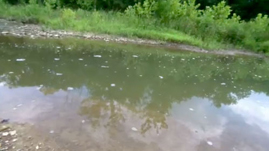Teachers' Domain - Digital Media for the Classroom and Professional Development
User: Preview


Funded in part by a grant from the U.S. Environmental Protection Agency under the Clean Water Act through the Kentucky Division of Water to the University of Louisville.
Special thanks to the Bernheim Forest and the Kentucky Division of Abandoned Mine Lands for their assistance.
This video explores how Bernheim Arboretum and Research Forest near Louisville, Kentucky restored a channelized stream to its original meandering path. In the past, farmers throughout Kentucky channelized or straightened streams to access the rich bottomland along the streambeds. Bernheim moved a stream that runs through the park back to its original path and replanted its banks with local plants appropriate for a riparian zone, the wetland area beside a stream. The video explains the environmental advantages of meandering streams: improved water quality, more diverse and healthy ecosystems, and reductions in flooding and soil erosion.
This resource is part of the Water Solutions collection.
Two features of the Bernheim Arboretum and Research Forest near Louisville, Kentucky are linked to the history of manufacturing and farming in the U.S.: the recycled cypress wood used to build the Visitor Center, and Wilson Creek, the stream that flows through the park. Both features are also the focus of environmental projects designed to improve water quality and habitat in the park.
Establishing a Cypress-Tupelo Swamp
The Bernheim Visitor Center is constructed from recycled cypress wood originally used for Heinz pickle vats. Although Bernheim had no part in the long-ago destruction of a cypress swamp to make the original vats, the staff decided they would pay nature back by creating a cypress-tupelo swamp at the southern end of Lake Nevin, one of several water features found in the park. This swamp is now a healthy wetland that provides a habitat for a variety of micro- and macro-invertebrates as well as birds like the Great Blue Heron and other wildlife.
Restoring Wilson Creek
Bernheim Arboretum and Research Forest, which was established in 1929, sits on 14,000 acres of old farmland in Bullitt and Nelson counties. Wilson Creek, the stream that runs through the park, began as a naturally meandering stream. However, like an estimated 90 percent of Kentucky streams, it was “channelized” or straightened by farmers who wanted to improve their access to the rich bottomland along the creek.
What the farmers did not realize at the time was that naturally flowing streams have many important functions in addition to moving water from one place to another. When allowed to flow as nature intended, streams:
Channelizing Wilson Creek caused the water to flow much more swiftly, eventually cutting into the bedrock and making the stream into more of a drainage ditch than a creek. The water moved so quickly through its channel that sediment didn’t have much of a chance to settle or impurities to filter out. Channelization had other negative effects. When a stream is channelized, it removes most of the riffle and pool structure, further reducing its filtering capabilities and destroying the habitat for aquatic flora and fauna. Riffles are shallow areas of the stream, while pools are areas of deeper water.
Channelization also affected the surrounding floodplain because water overflow had less opportunity to slowly be absorbed into bottomlands; this reduced the formation of “detached wetlands,” important breeding and nursery habitats for micro and macro invertebrates. In light of these environmental problems, Bernheim Arboretum and Research Forest determined that the best course would be to restore Wilson Creek to its former meandering path. To achieve this goal, Bernheim’s staff collaborated with the University of Louisville and the University of Kentucky College of Agriculture with funding from a U.S. Environmental Protection Agency grant overseen by the Kentucky Division of Water.
The crew went to work, using bulldozers to undo the channelization and recreate Wilson Creek’s meandering path. By reinstating that original path, Bernheim also slowed down water flow, reestablished the system of riffles and pools, and made it possible for detached wetlands to form once again. These improvements now are helping to prevent non-point-source pollution, soil erosion, and habitat destruction along the stream’s path. They also provide a model for farmers and others who might be interested in restoring channelized waterways on their land.
 Loading Standards
Loading Standards